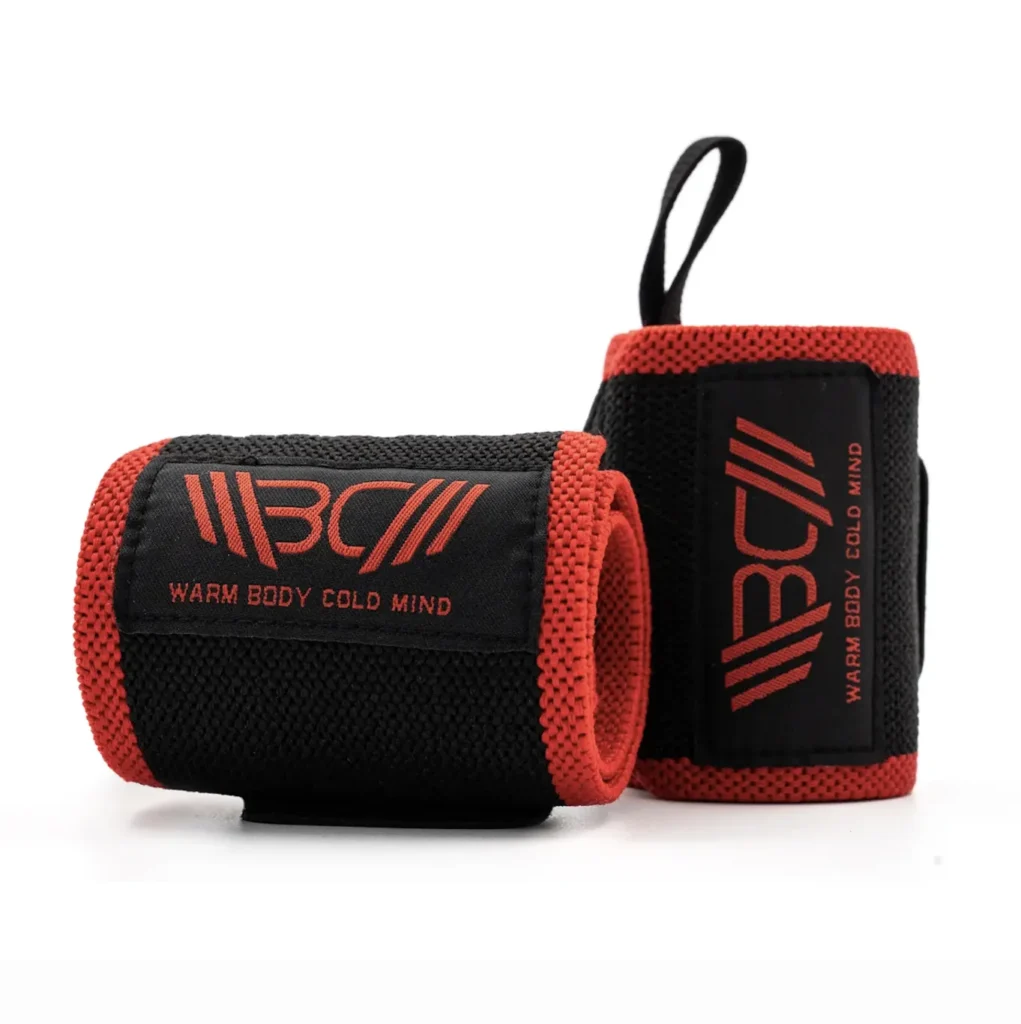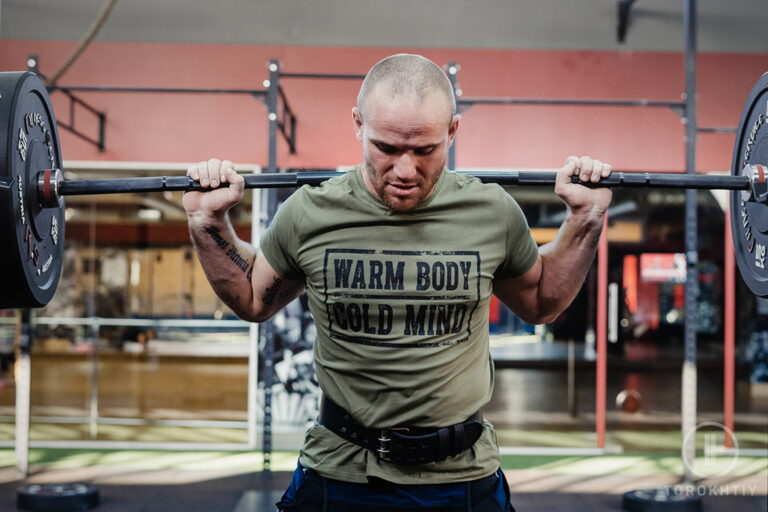Bench Press Wrist Position: The Beginner’s Guide
The bench press is one of the most popular weightlifting exercises. This is no surprise because it’s an extremely effective exercise. It’s also very easy, however, to get wrong. One common thing people get wrong is the bench press wrist position.
So what’s the best wrist position for bench press? How can you avoid doing it all wrong? We’ll find out in this article.
First, the short answer…
Many people bench press with their wrists bent 90° backwards. That’s a totally wrong bench press wrist position, even dangerous. You want to grip your barbell tight and keep your wrist straight or slightly bent.
Now let’s get into the full story. To fully understand why wrist position is so important, let’s look at some anatomy.

Wrist Anatomy During Bench Press
The bench press looks very easy to do, but many people get it completely wrong. One of the main reasons for this is that we don’t understand the anatomy of the wrist during bench press. The wrist is basically a connector between the forearm and the hand. So when you bench, the weight passes through your wrist to your forearm and the rest of your upper body.
As the connector, the wrist plays a critical role. If the weight doesn’t pass directly through your wrist, there will be strain. A common mistake people make is bending the hand backward or forward. This puts the wrist under extra stress because it’s no longer simply a conduit, but a support.
When your wrist becomes a support instead of a conduit for the level of weight bench press usually involves, it starts to grow weary. So it’s important to make sure that your wrist position is proper to avoid unnecessary stress on it. To do that, there are some rules you must keep in mind…
Bench Press Wrist Position Rules
There are five rules you must keep in mind that will help you find and maintain the best wrist form during bench press.
1. Grip the barbell at a proper width.
Finding the right hand placement for bench press starts with figuring out the right width between your hands when you grip the barbell.
A wide gap can cause all sorts of problems. Your forearms, hands and wrists won’t be in the same line and this will affect the flow of force from your body to the barbell. This will put the muscles in your chest and shoulders under extra stress.
On the flip side, a narrow gap is far from optimal. It will concentrate more load on your triceps and could wear you out more easily. Extra stress on your wrist joints could also make the exercise even harder to do properly.
A suitable grip width is just about the same as or slightly wider than your shoulder width. This allows better force transmission and gives you better stability.
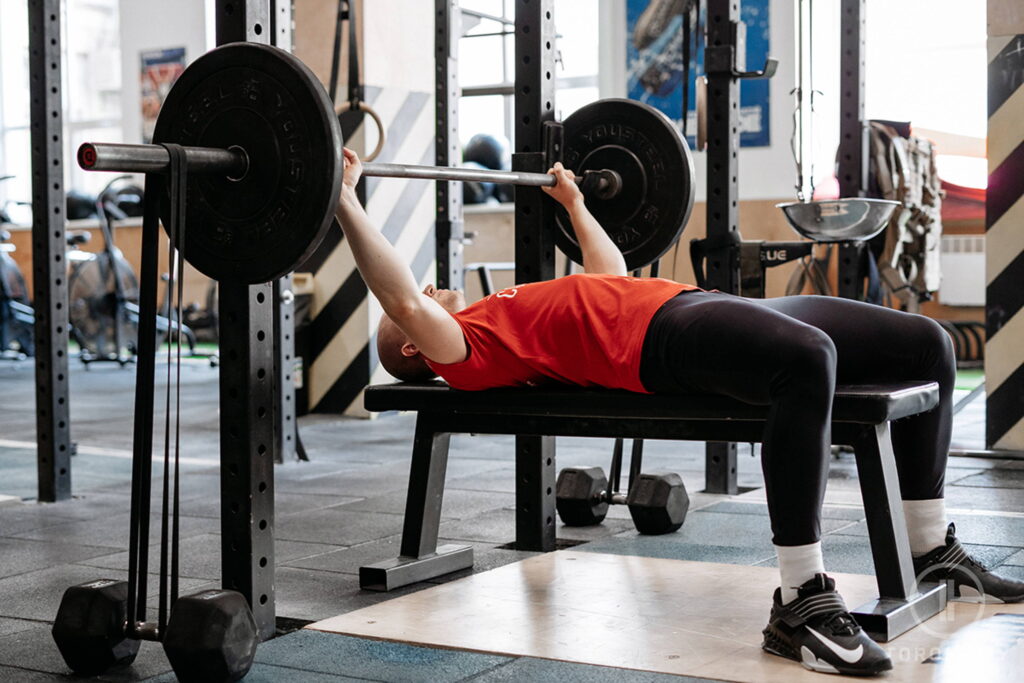
2. Place the barbell in your palm.
Some lifters, especially the less experienced ones, try to hold the barbell with their fingers. This move often ends with our wrists bent completely backwards, and that leads to its own problems. There will be no effective transmission of force from your body to the barbell, and you might finish with pain in your wrists.
What you want to do is to place the barbell in your palm. It’s the meatier part of your hand so it can cushion the weight much better than your fingers. More importantly, it lets you keep your wrist in the best position. This will let you lift weight more effectively and reduce the risk of joint pain in your wrist.
3. Use a Full Grip.
There’s some debate about this. Some lifters argue that a thumbless grip, also called a suicide grip or a false grip, is good for the bench press. My recommendation is to ignore such advice and use a full grip on your barbell.
A full grip keeps your barbell exactly where you want it. It allows for better force transmission, hence a more fruitful exercise. It’s also much safer to do, especially when there’s no spotter.
4. Keep Your Wrist In Line With Your Hand.
Two things you want to avoid when bench pressing are ulnar deviation and radial deviation. Ulnar deviation occurs when your grip is too narrow and your wrists start to deviate towards your pinky finger or ulnar bone. Radial deviation is more likely to happen when your grip is too wide and your wrists start to tilt towards your thumb.
Both ulnar and radial deviation can result in injury. Keeping your wrists in line with your hand ensures that the flow of force is optimal and the risk of injury is minimal.
5. Keep Your Wrists Neutral
A neutral wrist neither bends forward nor backward as you lift. This keeps the weight stacked directly on your wrist joint, allowing for smooth flow of force and reducing risk of strain.
You can have your wrist bent slightly backwards, as long as the weight remains stacked on your wrist joint.
Bench Press Wrist Position Mistakes
Mistakes in the bench press are as rampant as the exercise is popular. These mistakes revolve around the two staples of fitness: form and technique. Let’s have a look at some common mistakes and how you can avoid them.
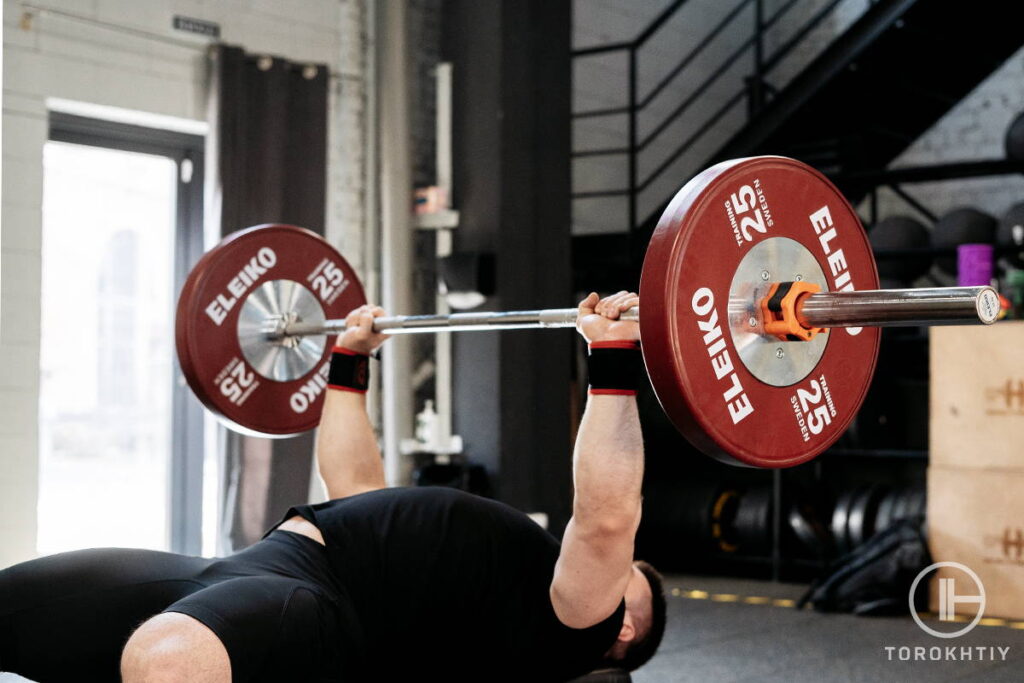
1. Going Too Heavy
Weightlifting lets you push your limits, but sometimes your limits are there for a reason. Maintaining good form and technique can be incredibly difficult when you’re lifting weights that’s way too much for you.
If you’d like to push yourself further, slow increase your reps to ease your body into it. Lifting weights that are within your body’s ability will make adhering to the bench press rules much easier.
2. Driving Your Elbows Out to the Side
The effect of flaring out your elbows is a subtle one. You might feel just fine for days, even weeks. Internally, however, your shoulder capsules and elbow joints are under enormous stress. This extra stress can build up into a damaging shoulder injury down the line. It also increases the pressure on your pecs.
The best position for your elbows is somewhat between 0 and 90°. Keep them just wide enough to give yourself a stable base, something like 75° away from your side.
3. Wrong Grip Width
This one is a rule. It’s important to find the right width for your hands when lifting. It gives you better stability and protects you from potential injuries such as ulnar and radial deviation.
There’s no specific distance because we all have different bodies. One way to go about this is to make sure your arms are at 90° to the floor or bench. If your arms are slanted in either direction, that’s a red flag.
Set your arms down flat on the bench, push your elbows out from your body to a suitable angle (about 75°), then make sure your forearms are perpendicular to the bench such that your wrist and hands are in a straight line.
4. Using a Suicide Grip
A suicide, or thumbless, grip makes it much harder to maintain a neutral wrist position. This could lead to strain in your wrist joints. It’s also not very safe because the barbell can slip out of your hands in the heat of the exercise.
A full grip gives you much greater control over your barbell. It makes a neutral wrist position easier to maintain and minimizes the risk of injury.
5. Bending Your Wrist
Whether forward or backward, bending your wrist is a bad move. It takes the weight off your wrist joint and loads your fingers instead. This means your wrist joint is under extra stress trying to support the weight. It could lead to pain in your wrist and other complications.
Keeping your wrist straight allows easier transmission of force from the body and minimizes the risk to your wrist joints. A slight backward bend is allowed, but make sure the weight is directly on your wrist joint.
How to Improve Your Bench Press Wrist Positioning
By now you know whether your bench press wrist placement is proper or not. To help you fix it, I’ve got some tips for you:
1. Use proper technique.
You know what I mean. Follow the rules of the bench press.
- Keep your wrists straight. This is the main rule. Bending your wrists forward or too far backward is what you want to avoid.
- Maintain proper grip width. This will give you stability and control of your barbell. Losing control of your barbell will either push the barbell to your fingers or cause deviation. You don’t want either of those to happen.
- Push your shoulders out inclined. This also helps with stability by making sure there is proper force transmission.
Follow the rules of bench press to the letter. This won’t be easy, especially if you’re already used to wrong positions, but building the habit naturally is the best way. It’ll teach you how to control your body and your experiences will only make you stronger in the long run.
Building the discipline yourself takes a lot of time, commitment and effort, however. If you have neither the time nor the desire to do that, there are other options. Let’s have a look.
🔻GRIP STRENGTH TRAINING PROGRAM
Struggling with Missed Lifts in Olympic Weightlifting?
Weak grips shouldn’t hinder your success.
Our specialized program, featuring 26 unique exercises and 18 workouts, focuses on strengthening essential hand muscles for Olympic weightlifters like you.
Don’t let your grip be the reason; start your journey to a stronger, more powerful lift today!
- 🌟 Targeted Grip Strengthening
- 🌐 Suitable for All Skill Levels
- 🔒 Lifetime Access – No Monthly Payments
Unleash your full potential. Click to transform your lifting game now!
2. Use dumbbells
One alternative is to switch up the exercise by exchanging the barbell for the dumbbell. The dumbbell press is friendlier to your wrist joints so they’re a no-brainer if you have some wrist joint pain. It also makes maintaining proper wrist position much easier. You can switch to dumbbell presses temporarily until your wrist joints are ready to go again.
The dumbbell press is also quite effective in muscle building and chest stimulation. It also allows a variety of movements that the bench press doesn’t. So you don’t have to worry too much about falling behind.
That said, this may not be the solution for you. You might not have access to Dumbbells or you might just not want to abandon the bench press.
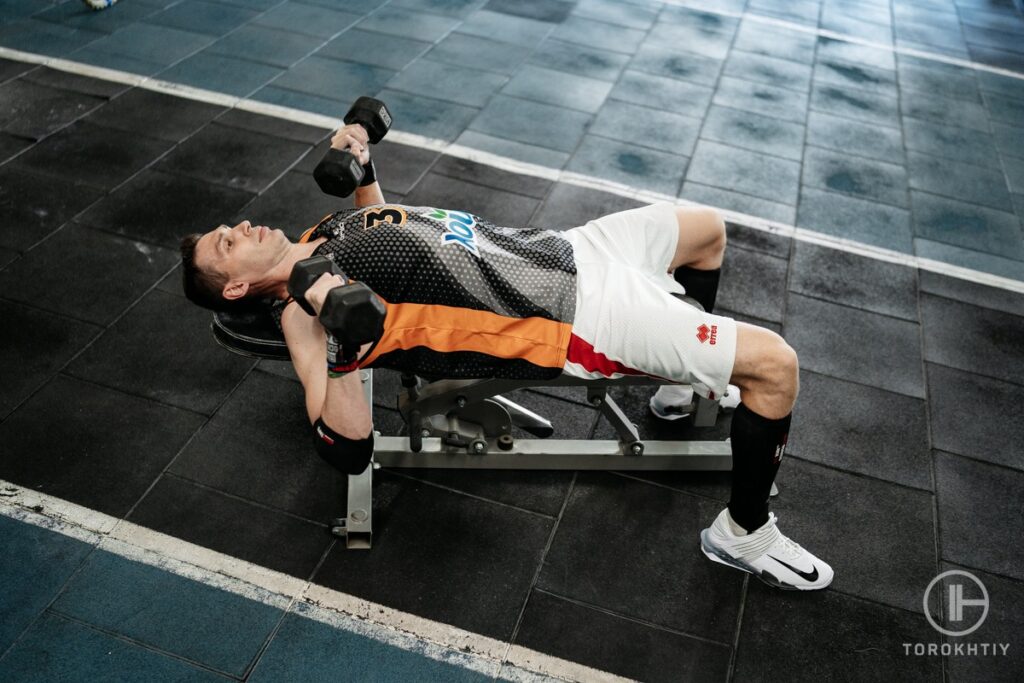
3. Use wrist wraps
Wrist wraps are cloth or leather bands that you wrap around your wrists for extra support and stability. They basically hold your wrist steadfast and keep them in the right form. They also serve as an extra cushion for the barbell in your palm. In short, wrist wraps shield your wrists and maintain proper form.
As awesome as that sounds, wrist wraps are not a permanent fix to a form and technique problem. All the wrist wraps do is give you an extra support while you master the proper way to bench press, especially the bench press hand position. Make sure you don’t become reliant on the wrist wraps because they will eventually stifle the development of your wrists.
Our recommended wrist wraps
Take a look at the Premium Velcro Weightlifting Wrist Wraps from the Warm Body Cold Mind. They provide all the support and stability you need for bench press. The elastic material also allows your wrist wraps to grip your wrist tightly but, at the same time, gently.
FAQ
Should your wrists be straight during bench press?
Yes. Straight wrists make sure there is proper force transmission during the exercise and minimizes the strain to your wrist joints. A slight backward bend is allowed as long as the weight is directly on your wrist joints.
What’s the best grip for bench press?
A full grip. The suicide grip is much harder to do properly and is more risky to do. It’s also not allowed in professional powerlifting. So just stick to the full grip.
Should I wear wrist wraps when benching?
Wrist wraps can be very helpful if you’re struggling with your bench press wrist position or if your wrist joints are in some pain. Make sure, however, that you don’t become reliant on the wrist wraps. The target is to bench properly without them. If you decide to use wrist wraps I recommend these ones.
Conclusion
Bench press is an extremely effective exercise. Doing it wrong, though, can mess up your fitness goals or even cause you injury. One of the most important things to maintain is the proper hand placement for bench press. The entire exercise depends on it. Make sure you follow the bench press rules so that your form and technique remain impeccable.
Now it’s your turn. Have you been getting your wrist position wrong? What’s your plan to fix it? Did I miss anything? Talk to me in the comments!
Also read:
- Bench Press Wrist Pain
- Front Squat Wrist Pain
- Handstand Wrist Pain
- What Do Wrist Wraps Do
- Low Bar Squat Wrist Pain
- Best Wrist Wraps For Powerlifting
- Ring Dips Functional Fitness
References:
- FALSE VS. CLOSED GRIP // RDLFitness: https://www.rdlfitness.com/blog/false-vs-closed-grip
- Everything You Need to Know About Ulnar Deviation (Drift) // Healthline: https://www.healthline.com/health/ulnar-deviation#symptoms
- Radial Deviation (Strength) // Saint Luke’s: https://www.saintlukeskc.org/health-library/radial-deviation-strength
- Dumbbell Push Press: Benefits and How to Do It // Healthline: https://www.healthline.com/nutrition/dumbbell-push-press
Why Trust Us?
With over 20 years in Olympic Weightlifting, our team does its best to provide the audience with ultimate support and meet the needs and requirements of advanced athletes and professional lifters, as well as people who strive to open new opportunities and develop their physical capabilities with us.
By trusting the recommendations of our certified experts in coaching, nutrition, dietology, and sports training programming, as well as scientific consultants, and physiotherapists, we provide you with thorough, well-considered, and scientifically proven content. All the information given in the articles concerning workout programming, separate exercises, and athletic performance, in general, is based on verified data. We ensure that you can rely on our professionals’ pieces of advice and recommendations that can be treated as personalized ones which will benefit you and fully meet your needs.
The product testing process is described in more detail here
Author: Ihor Shymechko
Pro Olympic Weightlifter, Coach
Best Results: Snatch – 208 kg,
C&J – 240 kg
Ihor has been a professional weightlifter since 1996, boasting over two decades of competition experience. His notable achievements include clinching the European Championship in 2009 and securing a silver medal in the 105kg division at the Senior World Championships in 2011. Ihor represented his country in the 2008, 2012, and 2016 Summer Olympics. After retiring from competitive weightlifting, he transitioned to coaching, leveraging his vast experience to guide athletes who now compete on both national and international stages.


